This post has not been edited by the GamesBeat staff. Opinions by GamesBeat community writers do not necessarily reflect those of the staff.
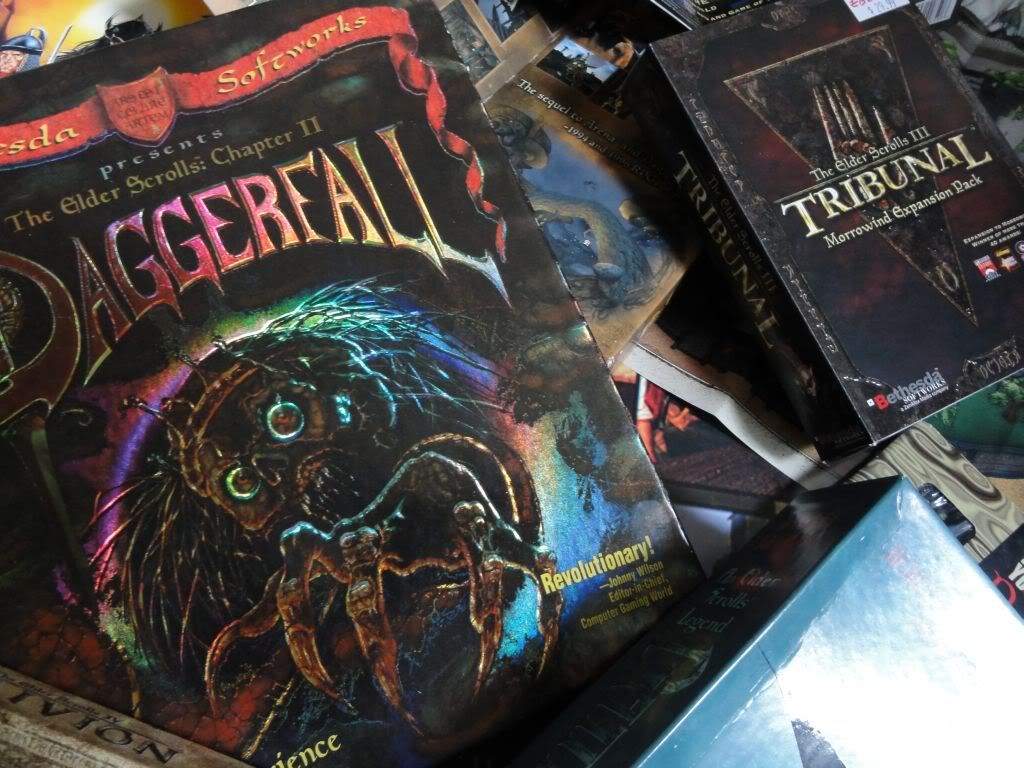
The Elder Scrolls have a massive history and the boxes to go with it.
In 1992, CGW had called Bethesda Softworks “The House that Gretzky Built” in a two-page spread that took readers on an insider's tour of the company. Up to that point, Wayne Gretzky's hockey games were its biggest licensed franchise along with the Terminator.
But it would be the “contrarian principle” acting as one of the company' founding influences that would come to define the company's most ambitious titles. As CGW noted, “…the concept was to develop a physical environment which adhered to physical principles.” It was an idea that created Gridiron!, Bethesda's first game.
And it would also be the hammer that would drive in the bolts and and beams for the vast world of the Elder Scrolls.
An Open World
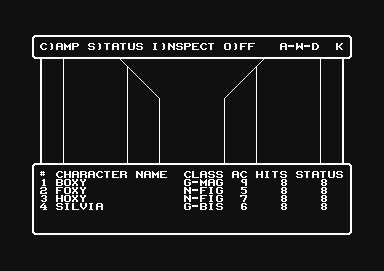 Whether it was Might & Magic's vast world or Wasteland's own scattered ruins amidst its post apocalyptic wilderness, the idea that there might be something else out there had always tickled the proverbial wanderlust in CRPG players for years.
Whether it was Might & Magic's vast world or Wasteland's own scattered ruins amidst its post apocalyptic wilderness, the idea that there might be something else out there had always tickled the proverbial wanderlust in CRPG players for years.
The early games boldly attempted to capture the essence of tabletop experiences such as Dungeons & Dragons and while the mechanics – with their pages of statistics and character formulae – were meat and potatoes to silicon circuits, creating convincing worlds as large as the imaginations of those playing the game proved to be harder.
And as technology advanced, so did designers' efforts to take full advantage of it. The idea of what an open world meant in the RPG space would also change alongside the expanding feature sets of CRPGs moving beyond simply satisfying an explorer's curiosity. Later, it would be about the kind of emergent gameplay that would enable players to literally write their own adventures, however small they might be.
Using the first-person perspective in a CRPG wasn't new – nor was the idea of using it in a larger, more open world. Baby steps from the early years were later expanded on by titles from Richard Garriott's Akalabeth in '79 and Sir-Tech's Wizardry series in the early 80s to New World Computing's Might & Magic: Secret of the Inner Sanctum in 1986.
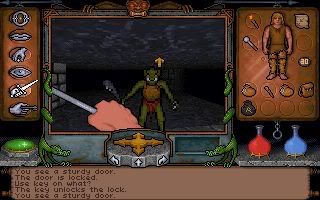 But moving CRPGs beyond the relatively crude, grid-based 90 degree movement model of the past had also been a goal, and more than one house was looking at how to do it. Bethesda's 1990 adaptation of The Terminator had used a free form, 3D open world design based on downtown Los Angeles with the player either as Kyle Reese or the Terminator to find Sarah Connor first. Blue Sky Productions (which would later become known as Looking Glass Technologies) had also been exploring their own direction with free form 3D having developed the incredibly influential Ultima Underworld for Origin, releasing it in 1992.
But moving CRPGs beyond the relatively crude, grid-based 90 degree movement model of the past had also been a goal, and more than one house was looking at how to do it. Bethesda's 1990 adaptation of The Terminator had used a free form, 3D open world design based on downtown Los Angeles with the player either as Kyle Reese or the Terminator to find Sarah Connor first. Blue Sky Productions (which would later become known as Looking Glass Technologies) had also been exploring their own direction with free form 3D having developed the incredibly influential Ultima Underworld for Origin, releasing it in 1992.
Coupled with the idea of a large, open world, this seemed to be the next obvious step in evolving the CRPG, at least as far as the environment went. Ultima Underworld had impressively shown just how involved it could be in an interactive dungeon setting, inspiring countless designers through the years after its release. But why stick with only a few floors of a dungeon when entire lands beckoned?
Bethesda Softworks sought to answer that question. Then a small software house, they had made their bones through a number of titles ranging from their work with Wayne Gretzky hockey games and the Terminator license.
It would also be a tough road for a developer that didn't have any background in CRPGs. As Bethesda's first role-player, Arena, took shape, Ted Petersen recalled in a 2001 interview “I remember talking to the guys at SirTech who were doing Wizardry: Crusaders of the Dark Savant at the time, and them literally laughing at us for thinking we could do it.”
Bethesda wasn't looking to be the new kid in the castle. They wanted to be the biggest dragon in the kingdom.
Treachery Across a Continent – Arena (1994)
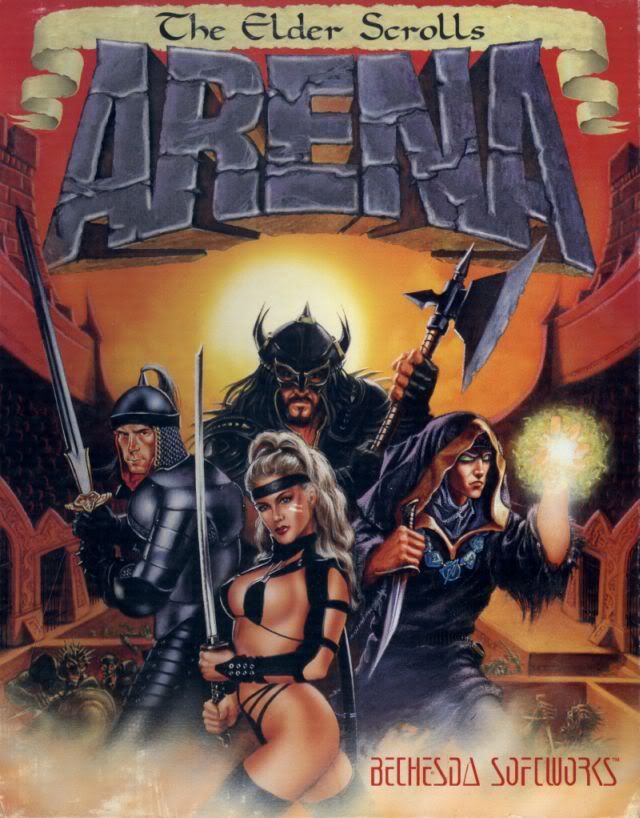 Bethesda's big gamble in the CRPG space with a highly ambitious, first-time title didn't start off so well.
Bethesda's big gamble in the CRPG space with a highly ambitious, first-time title didn't start off so well.
Future producer Todd Howard had just joined Bethesda when Arena hit shelves in '94 – yet it was supposed to be out in '93. Arena had missed the always important Christmas sales season.
Distributors were also expecting an actual game that took place in an arena. Bethesda had already printed up boxes with the arena-esque look on the cover, but the design had changed to incorporate a vast world instead. The distributors apparently didn't have as much faith in the 'new' game, and so an initial batch of only 3,000 units were sent out in March of '94 – not exactly prime time for something that had a lot riding on its success.
But despite the lukewarm response from critics such as CGW's Scorpia who praised the ambitious scope of the game but not so much the bugs and generic feel of its dungeons, it proved to be a greater hit among the players that lost themselves in Tamriel's wilderness becoming a solid success.
The initial intent was to have players fight their way to the top in an arena in order to face off against the usurper, Jagar Tharn, who was busy playing emperor. When it was changed to the huge, free-roaming open world of Tamriel, Tharn was still a villain but now quests, dungeons, cities, villages, and ruins lay spread across 8 million virtual kilometers of landmass. Tamriel became the 'arena', a land filled with strife and hardship. Quick travel was absolutely essential – simply walking to the next town could literally take an hour or so, much less crossing the continent.
The freedom that I had experienced roaming the dungeon tunnels and caverns of Origin's Ultima Underworld was already amazing, but Bethesda's Tamriel teased a land filled with vast possibilities – at least on the surface. You couldn't fry your own food and the main characters were literally two dimensional, but there were plenty of dungeons to search for goodies in addition to towns and cities populated with NPCs and potential quests. It was a dungeon crawling adventure on an incredibly vast scale.

The argument for quick travel was easily made in Arena, though days would still
pass as you traveled. Virtual days, that is.
Randomly generated side quests assured an endless feeding frenzy of trips out into the wilderness. Despite some of the repetition that would inevitably crop up, it filled the need for loot, monsters, and dungeon crawling mystery borrowing deeply from the designers' passion for the pen-and-paper RPGs. After awhile, certain dungeon layouts became pretty familiar – but it didn't matter much when there were monsters to kill and loot to carry off to the next store.
Character creation had two modes: you could either pick a class, or answer a series of questions Ultima-style to determine the best one for you. Eight races, each representing a region of Tamriel, awaited to dress your persona up in with their own advantages and disadvantages. After that, your quest began in the dank dungeons beneath the Imperial City as you made your escape – if you survived. As characters gained levels, another mechanism tripped in the game to feed them more valuable rumors translating into leads for further adventures.
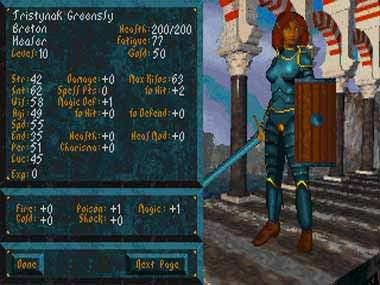
Enough statistics to make an CRPGers weep with joy
Arena also held onto the action roots that was initially envisioned with, now backed by a deep statistics-driven character development system. It didn't use the skill-based leveling that the Elder Scrolls series would later have as a standard. Instead, it relied on traditional experience levels earned through combat. Points were then allocated through several statistics affecting any number of performance aspects for your character. Yet biggest draw continued to be the vast fantasy sandbox holding it all together.
Nine provinces made up Tamriel along with a variety of races ranging from the Dark Elves (later called the Dunmer) of Morrowind to the cat-like Khajjit in Elsweyr far to the south. Snow blanketed Skyrim and the southern areas had palm trees and deserts. Day and night cycles added an additional level of realism with citizens hiding in their homes as darkness fell and dangerous critters braving the same to eat careless adventurers still left in the streets.
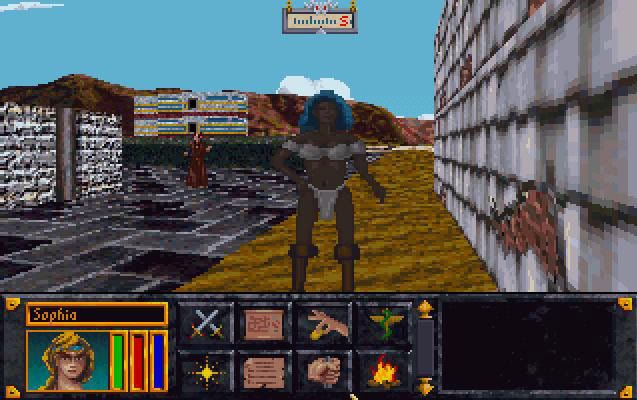 It was solid, but at the same time, not everyone had the kind of patience for the incredible level of recycled cityscapes and empty wastes that made up most of the visuals.
It was solid, but at the same time, not everyone had the kind of patience for the incredible level of recycled cityscapes and empty wastes that made up most of the visuals.
It also made it clear from the outset that this was going to be a series focused primarily on the kind of action that would mold character statistics moreso than it would engage them in deep conversation and skullduggery – these aren't the kind of story-driven titles that could be weighed against heavyweights such as Origin's Ultima VII, or much later, with BioWare's Baldur's Gate or Obsidian's Planescape: Torment. The Elder Scrolls series would always have a closer kinship with older dungeon crawls such as Interplay's The Bard's Tale, SSI's Demon's Winter, or Might & Magic from New Word Computing – sans party.
The vast, open, free-form world of exploration that left players unfettered within their own action-combat fantasy of would-be heroes had also emerged to become the driving focus of the series throughout most of its history leaving it free to win its own share of rewards. It would leave an indelible first-impression on the CRPG world as players were pulled into the potential that its seemingly limitless horizons painted.
In 2004, Bethesda made it possible to download Arena for free as a part of the series' 10th Anniversary. With the help of DOSBox and a little tweaking guidance from the Unofficial Elder Scrolls Pages, and as long as you can stomach the old school graphics, you can check it out and see what started it all.
Not bad for the house that Wayne Gretzky had built.
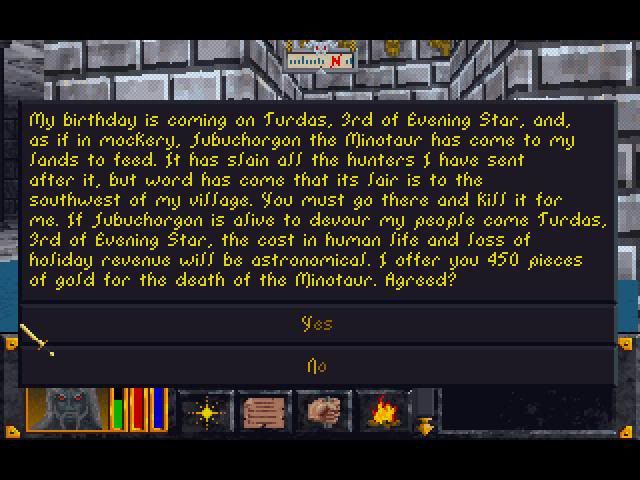
Arena was heavy on meaty text descriptions, not so much on
conversation
There are Enemies Near – Daggerfall (1996)
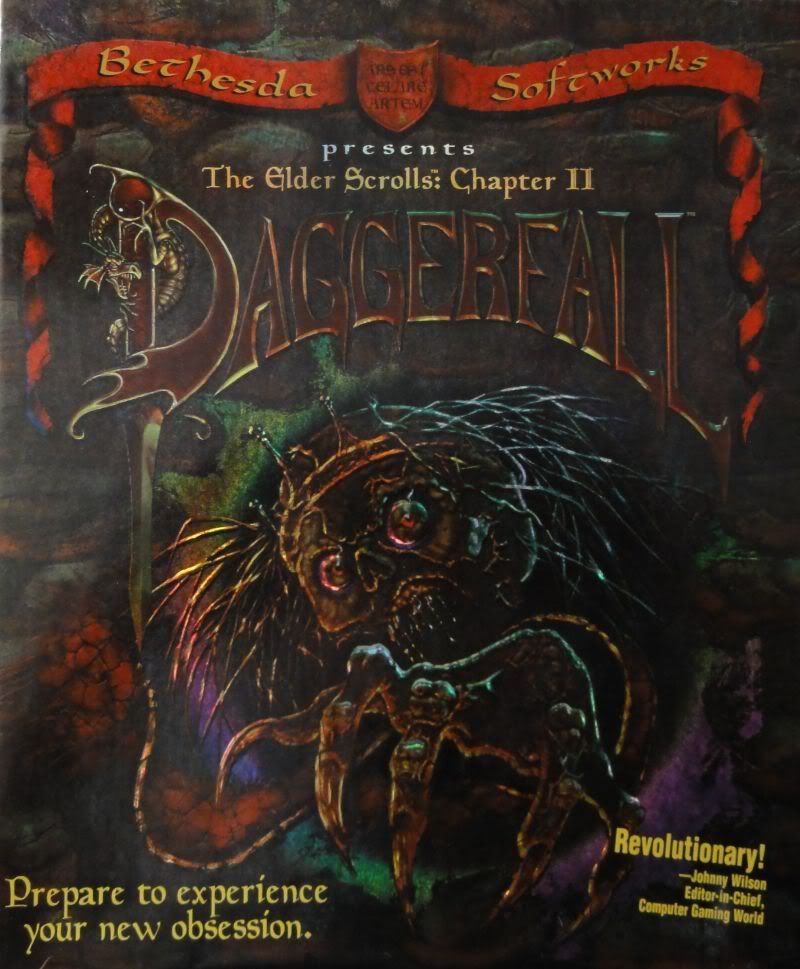 The Elder Scrolls would pull back from the vast spaces of Arena by focusing on individual provinces instead starting with its sequel, Daggerfall. Even shrunk down, Daggerfall boasted being roughly the size of Great Britain which still gave armchair explorers plenty of virtual real estate to walk around in.
The Elder Scrolls would pull back from the vast spaces of Arena by focusing on individual provinces instead starting with its sequel, Daggerfall. Even shrunk down, Daggerfall boasted being roughly the size of Great Britain which still gave armchair explorers plenty of virtual real estate to walk around in.
It was also the buggiest Elder Scrolls game in the series that I'd played. The worst things to happen to me in the game were the kind of that didn't have any hit points, especially when it made the main quest impossible to finish.
Clicking on an empty save slot usually booted me back to DOS (I hadn't adopted Windows 95 yet). I had been assigned a quest that gave me over seventeen thousand days to finish. My character fell through the map with some regularity along with getting stuck in the ground for no good reason.
Even today under a DOSBox package with all of the patches, it can still get the blood boiling with a few bugs that were never resolved like falling halfway into a puddle and getting stuck until I quick traveled out of it to another town. It was also always annoying to be unable to rest and heal up in a dungeon even though a monster was a floor above you with no way to bother you.
Yet when it worked, it pieced together a world that wanted you to move into and spend days exploring it. There's a good game buried under all of that frustration, one loaded up on character stats, skills, reputation, and plenty of do-it-yourself questing.
Daggerfall is the name of the capital of the kingdom that bears its name which is part of the province of High Rock where the main quest begins. A live-action briefing shows a meeting with the Emperor who tasks you to find out why the shade of a dead king is screaming for vengeance in the streets at night right before sending you off. Like all of the other Elder Scrolls titles, each one is a standalone adventure leaving previous efforts a part of history.
The game covered the provinces of Hammerfell and High Rock and filled them both with plenty of destinations and dangerous foes. There were no dragons yet, though players could fight freshly hatched dragonlings instead.
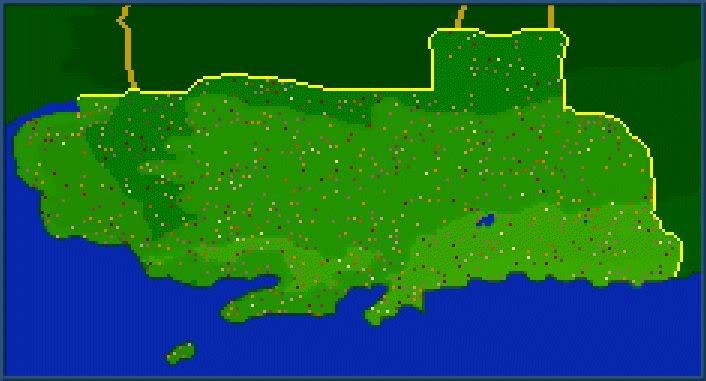
Each tiny dot represented a destination. And Daggerfall was only one area between
many others within High Rock and Hammerfell. You even had a search field to plug
in the names of places to find them faster. Insanity!
It was also where the Elder Scrolls shifted its advancement system from being experience-level based to today's more familiar skill-based model. The Q&A session returned to help determine which class fit your outlook during character generation, but Daggerfall now allowed players to create their own class from the ground up in addition to the stock choices. Inherent advantages or disadvantages, skill picks across three tiers, and even faction reputations could be tweaked and the class named to anything the player wanted.
Graphics were also overhauled, the spellmaker and item maker systems were vastly expanded, and the player could own property in the world for the first time such as ships and houses – though it was eerie to own a huge, empty ship devoid of crew. Banks stored extra coin the player earned – all that gold could weigh you down – and issued letters of credit in their place, Knights Templar style. Horses eased travel and you could even have your own wagon to haul more loot from every dungeon. Weapons had to be left for a few days at a blacksmith for repair.
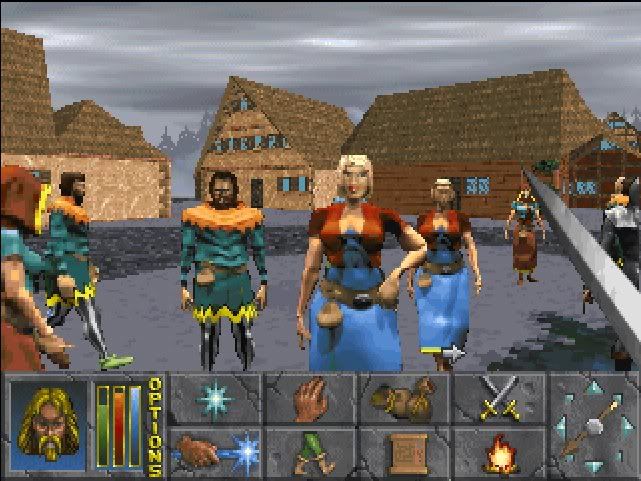
So many NPCs, so little time. And yes, you can pretend that you're Attila the Hun if
you wanted to and didn't mind being hated everywhere. Citizens didn't have great
loot, anyway.
Days counted because most quests gave you only so many to complete them and using the 'quick' travel option was absolutely necessary as it had been in Arena, estimating how many days would pass before reaching wherever it was you were heading to unless you wanted to spend hours walking. Which you could. Nothing was stopping you from doing that. If you had a horse or owned a ship, travel time could be cut short depending on where you went.
A greater emphasis was also placed on the story, moving it beyond the typical “slay the evil” mantra to split the climax into several different endings depending on what the player chose to do. It was still as linear as a dungeon corridor, but giving the player a choice in how it could resolve itself was a welcome bonus.
The reputation system, in particular, created the illusion of a wide network of overlapping interests and factions. Depending on certain actions by the player within the world, certain quests and notes might come their way that otherwise would not have, especially if werewolf hunters began seeing you as a threat.
Thanks to built in randomization, the landscape was generated on the fly and an endless slew of generic side quests kept the player busy for as long as they wanted to earn gold, goodies, or improve their reputation with a particular faction. This also presented a degree of deja vu in seeing some of the same buildings and dungeons after so long, as with Arena, but it helped suspend enough of one's disbelief with the illusion of a living world fraught with endless danger and rewards.
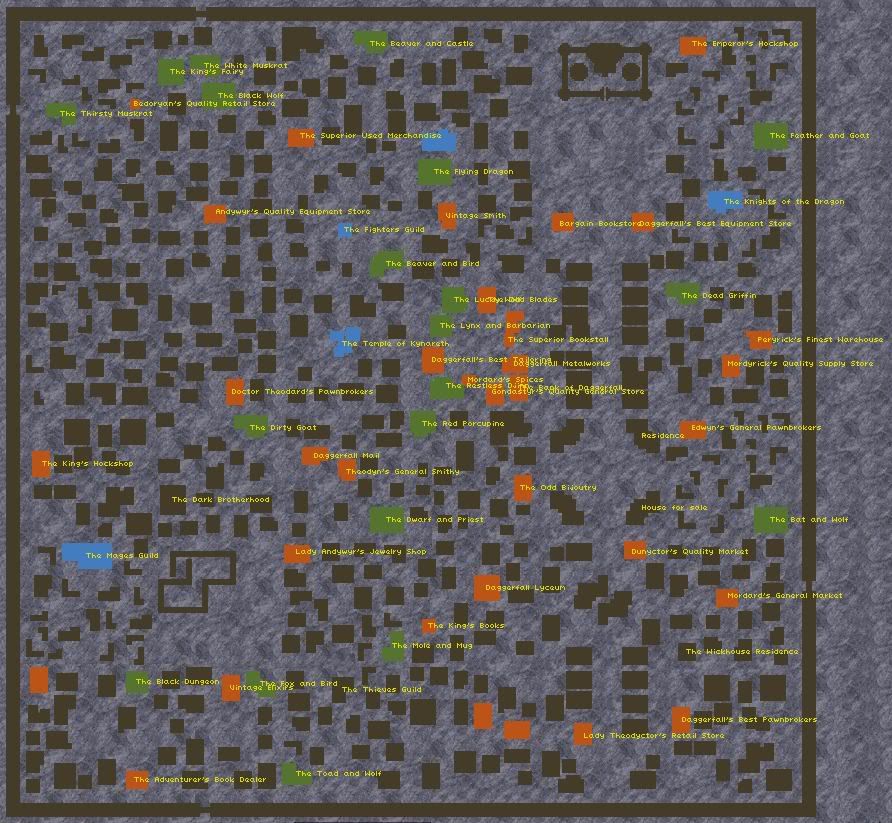
Cities in Daggerfall were titanic places filled with shops, guilds, banks, and houses just
begging to be robbed. Wait, did I say 'robbed'? I meant 'purchased'.
Like Arena, the game was also text heavy to describe certain areas or to expand the fiction of whatever quest you had undertaken. In addition to day and night cycles, seasons would change and holidays were further expanded on when certain daedra summoned at those times granted the boon of a quest to those seeking them. Libraries were filled with books adding more much-needed background to the Elder Scrolls' world, though the story was still as threadbare as its predecessor despite the multiple finales.
Daggerfall also wasn't shy in killing players, often at the hands of particularly powerful critters that could simply pop up into any of the dungeons without warning though that was considered a plus by some. Encounters scaled according to the player's level, though it wasn't obnoxious about it. It was never unusual to run into a number of low level mobs guarding a high level horror deep within a dungeon. Daggerfall's own immensity could also dilute this effect, lulling adventurers into a false sense of security until a Lich toasted them with a fireball after opening that last door.
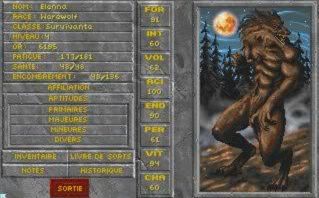 Vampires and werewolves had also added the potential to role-play an alternate lifestyle, though despite the dangers, anyone expecting secret wars, cabals, or a raft of quests to further expand on either role would be disappointed. For players that let their own imaginations take flight with these options, however, Daggerfall's night life suited them just fine.
Vampires and werewolves had also added the potential to role-play an alternate lifestyle, though despite the dangers, anyone expecting secret wars, cabals, or a raft of quests to further expand on either role would be disappointed. For players that let their own imaginations take flight with these options, however, Daggerfall's night life suited them just fine.
In the end, even with its issues, Daggerfall's promise was a tremendous step forward for the series. Even today, it has been cited as a source of inspiration by developers such as Armagan Yavuz for Mount & Blade. At the time, though, the shadow of its technical flaws weighed heavily against it which would be a problem that Bethesda vowed not to repeat again with Morrowind.
As part of the series' 15th Annversary, Bethesda made Daggerfall available as a free download for those willing to take the plunge in figuring out how to tweak it to run in DOSBox. The good news is that there's also a package out there with a preconfigured DOSBox for the game, though as I've mentioned above, it's still pretty buggy. There's also an extensive guide on the Unofficial Elder Scrolls Pages on how to get it work. It's definitely worth taking a swing through it if you're at all curious on why Daggerfall still stands out as the best of the series among many of the old school.
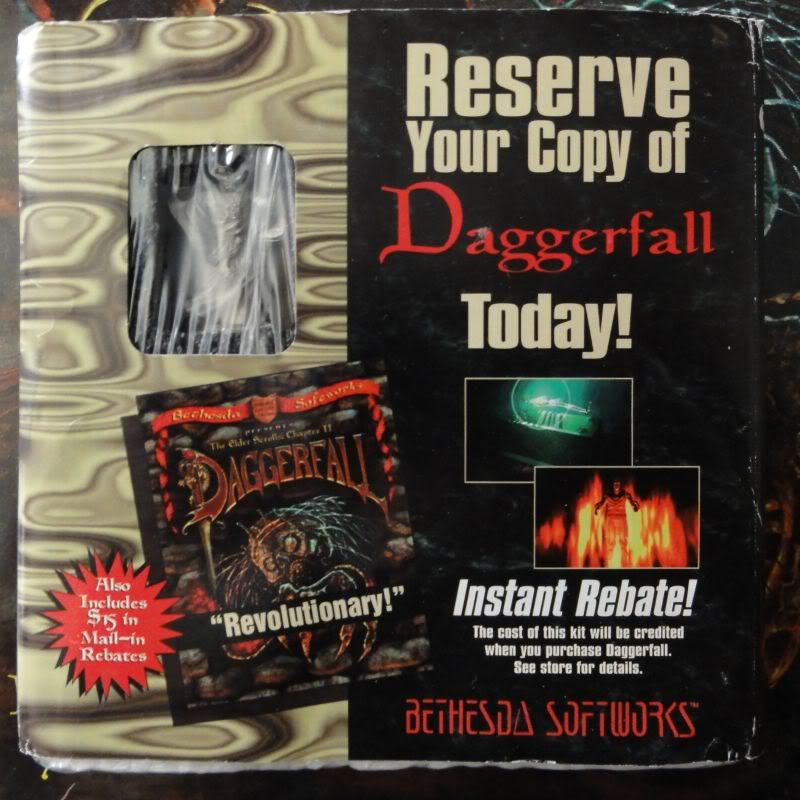
Before the Age of the DLC Code, Daggerfall had these pewter figures for pre-orders.
From what I could tell from the robes and head, the figure was probably the Underking.
Or some other really ugly guy in robes.
Dungeon Crawlers Only – An Elder Scrolls Legend: Battlespire (1997)
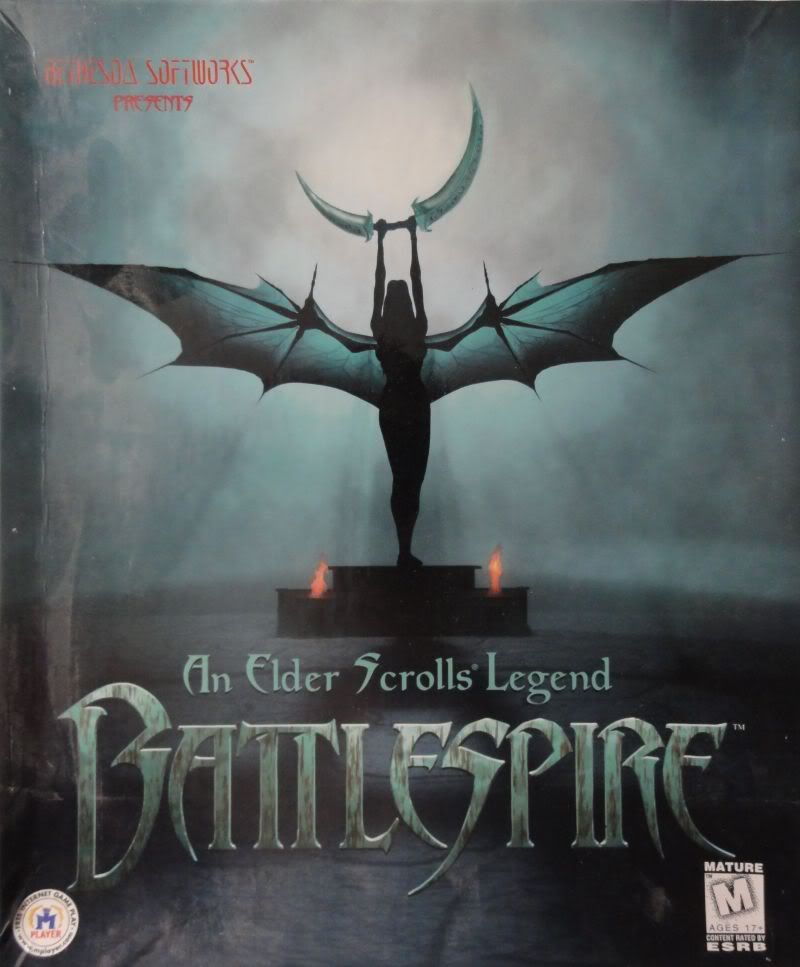 What was originally intended as an expansion for Daggerfall became a side story with its own game when Battlespire hit shelves under the “Elder Scrolls Legends” banner.
What was originally intended as an expansion for Daggerfall became a side story with its own game when Battlespire hit shelves under the “Elder Scrolls Legends” banner.
It was a radical departure from the series in terms of scope, resembling something more of a dungeon crawl than that of an epic adventure spanning cities, towns, and a tapestry of quests. It also probably didn't help that a certain dungeon crawler by the name of Diablo, released the year before, had crushed Daggerfall in sales.
Taking place at roughly the same time that Arena had, everything took place at the Battlespire – the training ground for the best of the empire's Battlemages. It expands on the story of Jagar Tharn's betrayal by introducing another piece of his plan to secure his usurped place as Emperor by wiping out those closest to Uriel Septim VII. And what does the evil wizard do? He invites the demonic daedra to dinner at the Battlespire, serving up his former comrades with a side of maniacal laughter.
Unfortunately, no one has realized what has happened to the Battlespire when you're sent there by magic to undergo its trials as a prospective candidate. As soon as you arrive, there's not much left of anyone to greet you thanks to the daedra. To make things worse, you're unable to return home to warn of the danger leaving it up to you to find a way to defeat these evil denizens and escape the Battlespire.
And you'll have to do it without stores, smithies, and temples to help you along the way. There's none of that in the Battlespire outside of special chests that repair gear only so many times and giant floating gems that bestow healing. Camping is also unavailable. Watching your gear get reduced to garbage from wear is always a worry.
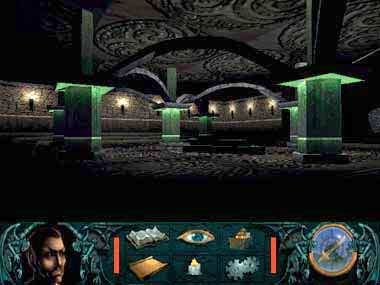
Battlespire was long on combat, short on survival.
For these reasons and others, Battlespire was much harder going than Daggerfall or Arena, yet it wasn't quite in the same league anymore, either. Though the character build system at the start had plenty of stats to roll through and gave you the ability to choose a decent lot of starting equipment, it became an old friend when I went back to it several more times after getting repeatedly pulped.
Though other games did well with the same approach – such as System Shock which took place in a giant space station – Battlespire felt too much like a cash-in on the Diablo phenomenon, stripping the Elder Scrolls first-person formula down to the bare basics to focus mainly on its action RPG aspects. For fans of the Elder Scrolls series, Battlespire wasn't quite the follow up they had expected and the game quietly disappeared from the retail space despite having a titanic box to show itself off with.
It's been years since I last played this one, though today I'd likely have to run it through DOSBox where its performance has been reported as hit or miss.
A Fistful of Fencing – The Elder Scrolls Adventures: Redguard (1998)
“Will there be a 3Dfx version?
Definitely! Redguard will use both Voodoo and Voodoo2 graphics boards. If you haven't purchased a 3Dfx card yet, Redguard will be the game that puts you over the edge and makes you run out and buy one.”
– from the official Bethesda FAQ for Redguard
 Following up Battlespire, Redguard was released under the “Elder Scrolls Adventures” label as Bethesda took a stab at the action adventure wave which was pretty popular at the time thanks to a certain adventurer by the name of Lara Croft.
Following up Battlespire, Redguard was released under the “Elder Scrolls Adventures” label as Bethesda took a stab at the action adventure wave which was pretty popular at the time thanks to a certain adventurer by the name of Lara Croft.
The first two Tomb Raiders had also come out in the two years before Redguard and despite the tank-like movement controls, getting Lara around her environment felt better implemented. Yet Redguard also brought a fresh look on the world of Tamriel thanks largely to the sharper focus on its story and a compelling lead in Cyrus the Redguard.
Unlike the other Elder Scrolls titles, stats weren't rolled up here – you were simply Cyrus the mercenary on his way to the island of Stros M'kai to find his lost sister. Cyrus was also a Redguard, a race of tough warriors from Hammerfell that were considered among the deadliest on Tamriel. The game also took place in the distant past during the conquest of Tamriel by Tiber Septim, the man who united the continent under the Empire though at this point, he wasn't quite finished beating down everyone into submission just yet.
This was a pure, adrenaline pumping, action-adventure game from the start. Platforms, jumps, fencing fights, and a large island filled with NPCs threw down the gauntlet. Despite the somewhat clunky controls, roaming around Stros M'kai as a vagabond corsair caught up in a struggle against the island's governor and the might of an empire was the kind of epic stuff adventurers expected.
The packaging had also expanded on the tradition of providing plenty of fiction with a manual crammed with lore and even a map complete with 'burnt' edges to more deeply connect players to the world behind the screen. Though Arena had started out with sparse material, the depth of the Elder Scrolls' lore improved over each installment especially within Daggerfall and the many books lining its virtual shelves. With Redguard, information providing an overview of Tamriel – a pocket guide to the Empire – was provided alongside the manual in much the same way that Garriott's Ultima series had served its own fans.
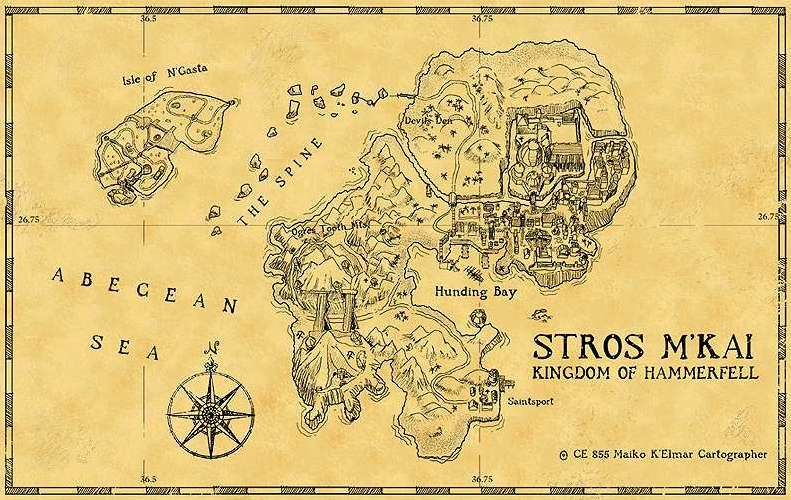
Maps like this only made things worse by laying things out and daring
you to get there.
Redguard's world didn't rely on a randomly generated environment to populate its comparatively small niche of Tamriel. The island of Stros M'kai was handcrafted from the dirt up, an approach that would come to define the Elder Scrolls' design efforts from then on.
A cast of unique characters also framed the backdrop of Stros M'kai providing side quests and valuable information on the goings on around the island. As with Daggerfall, digital books scattered about lent even more juicy tidbits on the history of the world expanding on Tamriel's mysteries.
Redguard is also the first, and until Skyrim, only Elder Scrolls game to officially feature a grown dragon as an antagonist. Adding dragons to the series had always been something of a goal, though it wouldn't be until Cyrus met one himself in this game that players would actually see one. Players, however, would have to wait until Morrowind to actually see dwemer, the 'dwarves' of the Elder Scrolls, whose masterless mechanisms and buried ruins had only tantalizingly hinted at their passing.
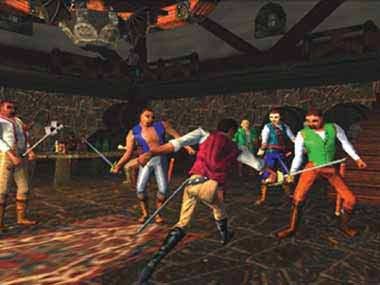
Safety note – never make a grab for a Redguard's fish 'n chips
Redguard was also programmed to take advantage of the 3DFX Voodoo cards that were all the rage back then and as a result, can be finicky to emulate with today's hardware. Bethesda never bothered to patch the game to work with other cards, but at least included software emulation. But DOSBox will only be able to take you so far unless you can run the thing on a PC natively running MS-DOS or Windows 95/98 thanks to a specific error that it can't work around. One of these days, I might have to convert a PC to DOS just to finish this.
It's too bad that Bethesda did nothing more with the game after its release. Redguard, despite the rough edges to its blade, was an action adventure game that really felt as if it tried to do something different, bold, and fun with the Elder Scrolls series.
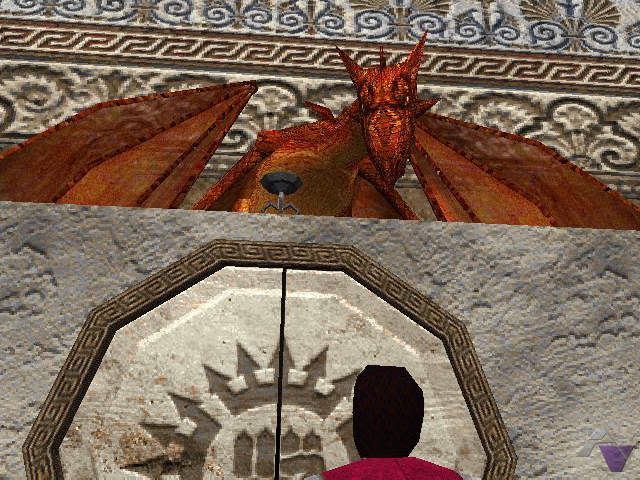
Redguard's dragon wasn't some dumb beast – he was a mercenary working for Tiber Septim and none to happy about seeing Cyrus.
Ash and Smoke – Morrowind (2002)
“I think it's pretty dangerous to try to expand your game's appeal too much. If you try to make everyone like a game, you end up watering it down so no one will like it. From everything I've seen, Morrowind will be infinitely more accessible than Daggerfall was, but it'll be a far cry from the dreaded "RPG-Lite."”
– Ted Peterson, Morrowind Italia Interview (2001)
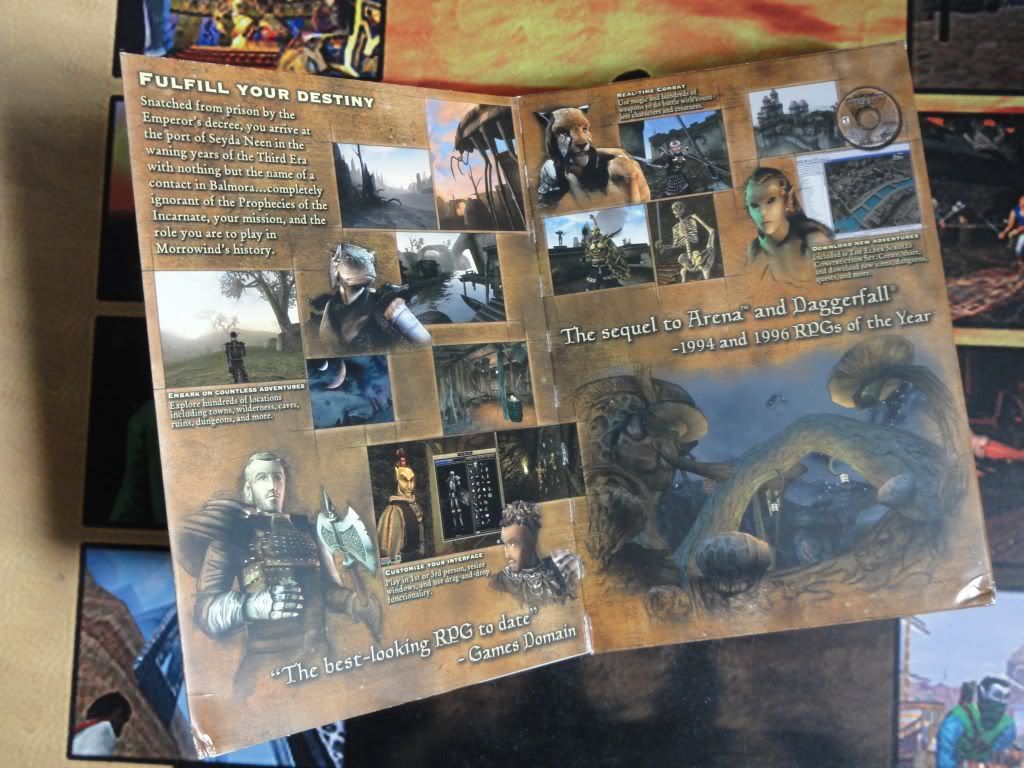 After the relatively lackluster performance of both Battlespire and Redguard, Bethesda focused on its sports games for a time. It would also be planning a return to what the Elder Scrolls had done best. Though ideas had been brought up to build the sequel following Daggerfall, they were shelved until after Battlespire and Redguard had come and gone.
After the relatively lackluster performance of both Battlespire and Redguard, Bethesda focused on its sports games for a time. It would also be planning a return to what the Elder Scrolls had done best. Though ideas had been brought up to build the sequel following Daggerfall, they were shelved until after Battlespire and Redguard had come and gone.
Todd Howard, now Project Leader, and his team along with Elder Scrolls design alum, Ken Rolston, focused on the next big chapter of the series with new technologies, a better story, and the kind of free-form experience that players had yearned for since Daggerfall. Following Redguard in '98, Morrowind arrived in 2002.
Morrowind was slightly deceptive in that you didn't get ALL of Morrowind – only Vvardenfell, the central, island where the spiritual and administrative heart of the province lay in wait for you to loot it. Vvardenfell's grey, ashen landscape was crafted piece by piece by artists and designers, not randomly generated, turning it into a unique, if not bleak, wonderland of strangeness. The Dunmer, or 'dark elves', were fleshed out to be far from being the kind of 'evil' scum that other fantasy worlds had branded them with. Xenophobic, but not quite the Machiavellian slavemasters from other worlds.
The same free-form, do-it-yourself approach allowed the player to mold their character in any way they saw fit thanks to the skill-based leveling system that was introduced in Daggerfall and had been used sparingly in Battlespire. Creating your character was similar to the way it was done in Daggerfall, either through questions, picking a class, or rolling your own skills and stats into a personalized package of punishment. Two new races were even added to the regular roster of eight, Wood Elves and Orcs. However, certain other details were conspicuously missing.
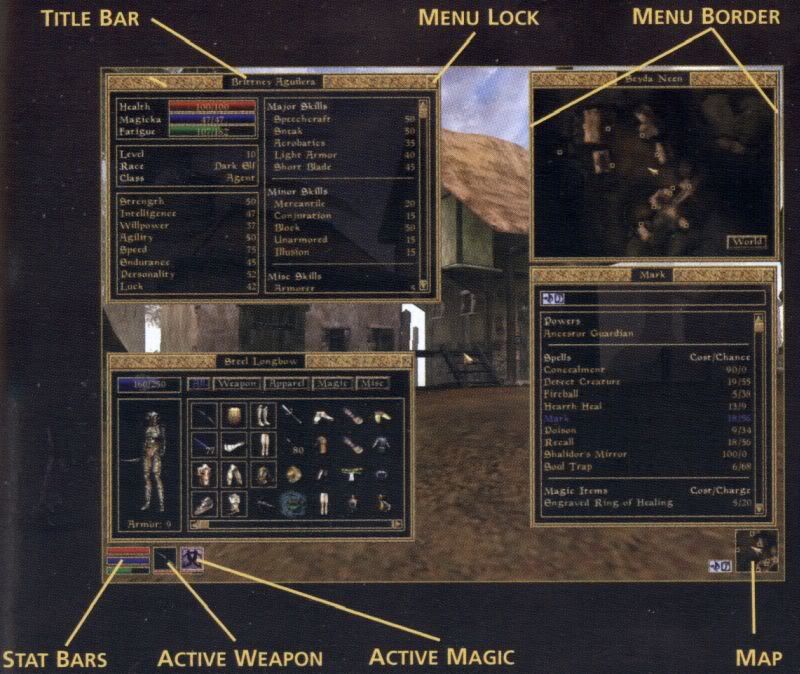
Morrowind's interface placed a lot of information at your fingertips
Customization was slightly simplified with several skills bundled into others or eliminated entirely. Specific advantages and disadvantages to affecting how a custom class would improve over time were conspicuously missing, replaced instead with a new Signs system under which your character was born. Though not as extensive as Daggerfall's character creation system, it still provided enough crafting depth to make it well worth the time spent planning out personalized builds.
In exchange for greater, handmade detail and less generic, randomly generated scenery, the size of the world had also been squeezed down. The vast political backdrop insinuated through Daggerfall's many factions and corresponding reputation hooks had also been streamlined, though one could probably argue that the province of Morrowind isn't quite as divided as Hammerfell's or High Rock's.
The dungeons had also been given more of a meaningful character – individually crafted locales skewed away from the convoluted halls, hidden doors, and lever-activated platforms of Daggerfall's labyrinthine underworld. Though smaller as another compromise towards quality, they were still as fun to explore when you had to know what was just around the other corner – such as whether the dwemer had left any living machines behind to mind their homes while they were gone.

From the soaring halls of Vivec to the fantastic architecture of Sadrith Mora, Vvardenfell
had plenty for the player to gawk at – and to hint of adventures that might be just
around the next mushroom
But one thing I missed most were the randomly generated quests. In both Daggerfall and Arena, the main quest could be ignored for as much loot and experience as I could stomach through their randomly generated side jobs. The exercise could also get repetitive, but it still provided an extra CRPG flavored option that I couldn't get enough of. Morrowind's quests were finite, yet despite that, there were still a great many to sink countless hours into.
The core experience had also succeeded in continuing to inspire curious exploration and do-it-yourself moments whether it was to rob the vaults of a Great House or in deciding to punch a living god to death (though a warning on breaking the story and suggesting restoring to an earlier save would pop up). The spell maker made meddling with dangerous magic as useful as ever, especially if you weren't so good at picking locks as my character was at the start. The freedom to play your character in any way you saw fit had little changed since Arena.
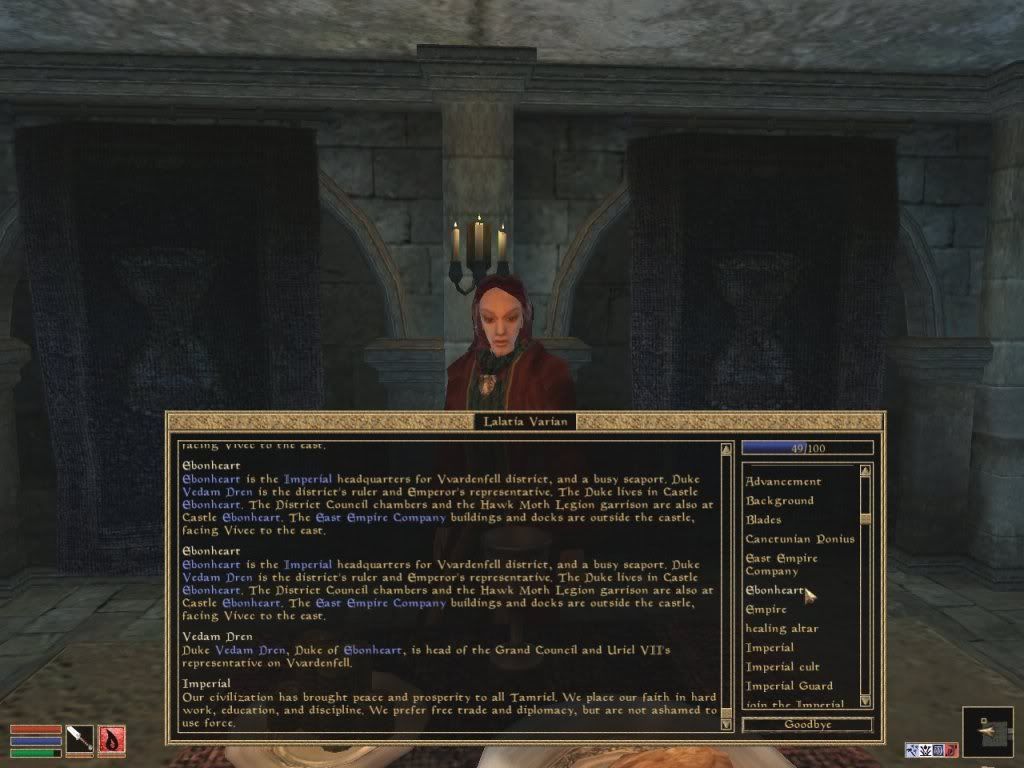
If you loved to read, Morrowind's dialogue system is for you. People could deliver paragraphs of information if they liked you enough and provide enough topic hyperlinks to be their own wiki
before wikis were fashionable.
Guilds still wanted your membership with the additional bonus of rising up far enough to become the master of each. Some of my favorite ones belonged to the Morag Tong, the secretive assassin's guild, though not so secretive as to make their hideout too hard to find. Though you couldn't purchase properties in the same way that you could in Daggerfall, it wasn't missed as much as it otherwise might have been thanks to opportunities provided by other factions in earning a safe place to crash for both you and your stuff.
The blasted, fungal landscape was also an alien place sowing a sense of the unknown that was so important to any CRPG. From the look of the Dunmer cities to the names and mythos surrounding the spiritual heart of the land, the province was far from being anyone's favorite vacation spot – unless you're an adventurer, or a skooma peddler – as well as revealing the fissures between the Empire and the Dunmer.
“Your journey is an adventure. You don't just decide "I wanna be across the world". It should be an adventure, we should take advantage of it, y'know, getting somewhere. Finding a dungeon travelling up in the mountains, battling away through stuff. Roadside adventures are cool. Finding a guy on the side on the road, like "Have you seen my wagon?" That's cool, we're missing this opportunity by just having fast travel.”
– Todd Howard, Interview with Morrowind's Developers by Game.EXE (reprinted at The Imperial Library)
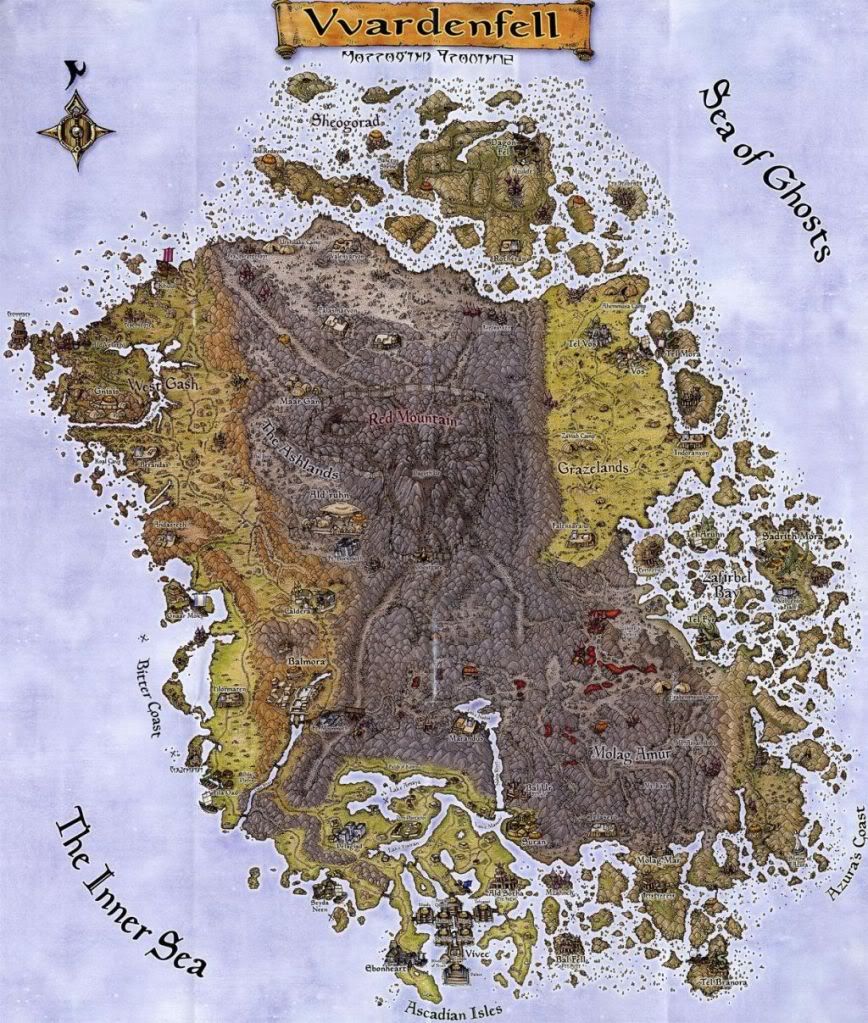 Travel also had plenty of options. Characters with a little magic up their sleeves could use mark/recall spells to zap themselves about, but there were also dwemer ruins that were part of a teleportation network. You could also pay for passage on a towering silt strider, hire out one of several boats, levitate your way over the landscape, or just hoof it. There's even a quest that asks you to walk the length of Vvardenfell without talking to anyone.
Travel also had plenty of options. Characters with a little magic up their sleeves could use mark/recall spells to zap themselves about, but there were also dwemer ruins that were part of a teleportation network. You could also pay for passage on a towering silt strider, hire out one of several boats, levitate your way over the landscape, or just hoof it. There's even a quest that asks you to walk the length of Vvardenfell without talking to anyone.
Bethesda had also included, for the first time in the series, a construction set allowing would-be dungeon masters on the PC to take a stab at making their own adventures. Even today, one of the most ambitious mods – Tamriel Rebuilt – continues to plug along with the goal of re-creating the entire continent outside of Morrowind.
Morrowind also represented Bethesda's first big gamble for consoles; a complex, sprawling CRPG that would introduce Tamriel to a new generation of players in the same way that choice Western conversions including several from SSI's AD&D catalog or New World Computing's Might & Magic series had tried to do over the years.
The open world was a trait that was welcomed on both consoles and PCs though it was sometimes mentioned as a double edged sword by reviewers. Players more accustomed to the linear world of JRPGs could find the open freedom of Morrowind intimidating and even frustrating. Yet it was still vouched as a critical success among those that inevitably, and willingly, lost themselves within it.
At the same time, the Xbox had a dearth of RPGs – a problem that it would never fully put behind it – and Morrowind was one of the first to fill that space. It would be joined nearly more than a year later by BioWare with Star Wars: Knights of the Old Republic. Jade Empire would follow, and Obsidian would get in on the action with KOTOR II.
While it might be a little too much to say that Bethesda's Morrowind had paved the way for WRPGs to begin their climb to prominence years later in the console space, its success along with that of its peers did make the Xbox a showcase for what Western RPGs could also bring to control pads everywhere. The rest, as they say in the business, is history.
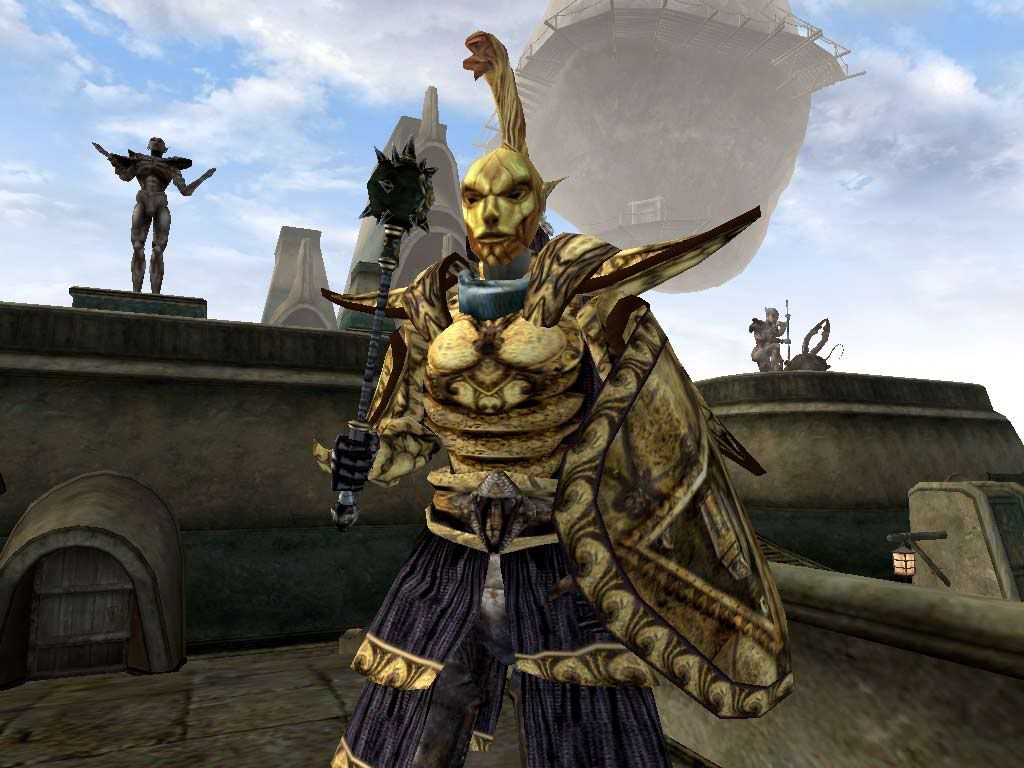
Vivec's Ordinators were no one to mess with lightly, though everything you saw on them was
lootable. And the armor was pretty useful…not that I had anything to do with the Ordinator that
didn't come back from patrol.
Expanding the World
Morrowind would later be expanded on with two sizeable additions – Tribunal and Bloodmoon – several months later, providing not only more gameplay but tweaked improvements to the main game itself. Though PC players would get these as they came down the pipe, Xbox players would only get them as part of a Game of the Year edition released later for both platforms.
Immortal Games – Tribunal (November 6, 2002)
 In Tribunal, the city of Mournhold – capital of Morrowind – was added along with an epic quest line that would determine the future of the three Dunmer immortals of Vvardenfell. Even if you hadn't finished the main quest, that little detail didn't keep anyone from experiencing this adventure – or in collecting the new loot that it had to offer. Despite as much fun as it was to play through this lore intensive addition, some it could come off as a bit underwhelming.
In Tribunal, the city of Mournhold – capital of Morrowind – was added along with an epic quest line that would determine the future of the three Dunmer immortals of Vvardenfell. Even if you hadn't finished the main quest, that little detail didn't keep anyone from experiencing this adventure – or in collecting the new loot that it had to offer. Despite as much fun as it was to play through this lore intensive addition, some it could come off as a bit underwhelming.
Compared to Vivec and its floating Ministry of Truth (which was a tiny moonlet stopped in midair ages ago by Vivec himself) and the size of its cantons, Mournhold seemed tiny by comparison – it was like comparing Washington D.C. to New York City. The fabled Clockwork City, even with its unique architecture and strange science, came off like a large dungeon instead of the demesne of a living god. Maybe I was hoping for too much.
However, the quest itself tied up important points from the main game and created the potential for reshaping the future of this corner of the Empire – if any other game were to follow up on these events. Despite the relative linearity of its dungeons and the self-contained world of Mournhold, the quests put the player in touch with legendary characters and made them a part of epic events.
Howling Fury – Bloodmoon (June, 2003)
 More than a year after Morrowind's release, Bloodmoon would arrive to satiate the werewolf yearnings of those that missed that particular wild side of life from Daggerfall. The second and final expansion would also give players a taste of Nordish life within the icy wastes of Solstheim on the fringes between Morrowind and Skyrim. Instead of a collection of buildings, the island threw even more sand into the Vvardenfell sandbox to run through your RPG fingers.
More than a year after Morrowind's release, Bloodmoon would arrive to satiate the werewolf yearnings of those that missed that particular wild side of life from Daggerfall. The second and final expansion would also give players a taste of Nordish life within the icy wastes of Solstheim on the fringes between Morrowind and Skyrim. Instead of a collection of buildings, the island threw even more sand into the Vvardenfell sandbox to run through your RPG fingers.
Players can help build a mining town and even become a werewolf, playing through Morrowind's main quest as a hungry beast on two legs for an additional challenge if they wanted. It was a fairly straightforward expansion packed with plenty of quests and free exploration. Depending on your level, it could either be a tough cakewalk or a vicious beating. My guess is that by the time this came out, they assumed everyone would have godlike characters to play through it with.
After dancing with gods in Tribunal and the main quest in Morrowind, Bloodmoon twisted together the threads of a story rife with ritual and heavy dose of combat. Solstheim wasn't a place for the meek, or the poorly leveled, but there was plenty to do. It also did a few things outside of the usual killing such as helping a colony grow on the island, or finding a way to howl at the moon in a different skin as a werewolf though that met with some mixed results.
It would also be the last expansion for Morrowind, though the mod community would continue to plug away with their own adds for years afterwards. Even though development of Oblivion began right after Morrowind had hit the shelves, it wouldn't be until 2007 that players would revisit the Elder Scrolls.
Though if you had a mobile phone or an N-Gage, the wait might not have been quite as long.
The Elder Scrolls Travels
All of these were developed by Vir2L, an internal studio of ZeniMax Media (of which Bethesda Softworks is also a subsidiary) specializing in mobile development.
With Oblivion under construction, these pocket-sized dungeons attempted to branch out the Elder Scrolls to other venues with relatively muted results. As with the major entries of the Elder Scrolls series, each game is standalone requiring little from the player other than a quick pair of thumbs.
Stormhold – (2003)
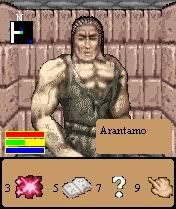 If you had never heard of this, you're not the only one. I only found out about this game when I started doing a little research and stumbled upon it at the Unofficial Elder Scrolls Pages.
If you had never heard of this, you're not the only one. I only found out about this game when I started doing a little research and stumbled upon it at the Unofficial Elder Scrolls Pages.
This Java-based mobile title crammed a dungeon prison into cell phones complete with loot, classes, and a diet of combat. Thrown in as a prisoner, players must find their way through to face a sadistic warden and escape to the surface. While it wasn't long on looks, or story, it was a simple dungeon crawler for those long, real life commutes.
That also depended on the type of phone you had – the size of the game could vary between 8 dungeon areas and six classes to 36 dungeon areas and seven classes. As for the gameplay, it was reminiscent of older real-time CRPG dungeon crawlers such as Westwood's “Eye of the Beholder”.
Grid-based movement meant 90 degree turns and block movement from one square to the next as in the old days. Battle was in real-time and often depended on how quick you could hit the attack button. An automap also gave you an idea of what was around you, though it had the annoying tendency to turn along with your viewpoint in the main screen. It also had NPCs for training, loot (though carry space was limited), and a save-anywhere mechanic.
Shadowkey – (2004)
Developed exclusively for the N-Gage, this was probably the most ambitious attempt to bring the Elder Scrolls to a portable system. It featured free roaming movement, solid 3D graphics, plenty of action, and a huge world to explore.
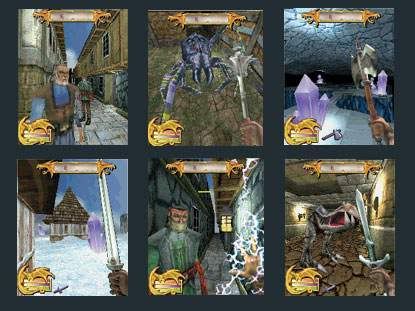
The game also adds to the lore surrounding Jagar Tharn, the treasonous usurper who pretended to be Emperor Uriel Septim VII from the first Elder Scrolls game, Arena. Here, the player is pulled into a secret war on the frontiers of Hammerfell, High Rock, and Skyrim where an arcane power must be kept from Tharn's wizardly grasp at any cost.
With eight races to pick from for any of its nine classes, plenty of NPCs in a variety of locales, and a sandbox-like openness to exploring Shadowkey's world, it appeared to be an appealing addition to the Elder Scrolls series. It was a solid slice of the kind of gameplay that its larger cousins boasted, only in a smaller dose.
Unfortunately, the game had also suffered from a number of technical issues ranging from slow loads between areas and frame-dropping slowdown to pop-ups and a clunky combat system. Its exclusivity to the doomed N-Gage also didn't help and when Nokia's bold experiment eventually died off, so did the game along with most of its library.
Dawnstar – (2004)
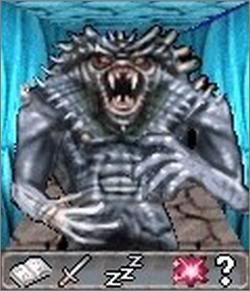 Later in the same year that Shadowkey appeared on the N-Gage, another Java-based mobile game appeared on cell phones for the Elder Scrolls. Dawnstar was a lot like Stormhold, right down to how many dungeons and classes were available depending on your phone model.
Later in the same year that Shadowkey appeared on the N-Gage, another Java-based mobile game appeared on cell phones for the Elder Scrolls. Dawnstar was a lot like Stormhold, right down to how many dungeons and classes were available depending on your phone model.
This time, players found themselves at the town of Dawnstar in the northern wastes of Skyrim. A traitor lives among you, though because the governor has no idea who it is, has banished four suspects from the town who also happen to be his champions. It falls to you to find out who seeks to betray Dawnstar to the Ice Tribes besieging the garrison and bring back those three who are innocent to help defend it.
Though the gameplay is the same as in Stormhold, the story is unique in that it asks you to collect clues and eventually unmask the traitor as an investigator instead of simply slaughtering your way through to the end.
Oblivion – (Canceled, 2007)
This was a curious bit of history that seemed to have all of the hallmarks for success, only to disappear into the annals of vaporware.
A version of Oblivion, specifically created for the PSP, had been rumored and then confirmed for Sony's portable in 2006. A few screens had even made it out including a video showing off some of the free-roaming gameplay. The bad news was that any hope for a Shadowkey-like Elder Scrolls taking its cue from Oblivion were dashed when it had simply evaporated a year later.
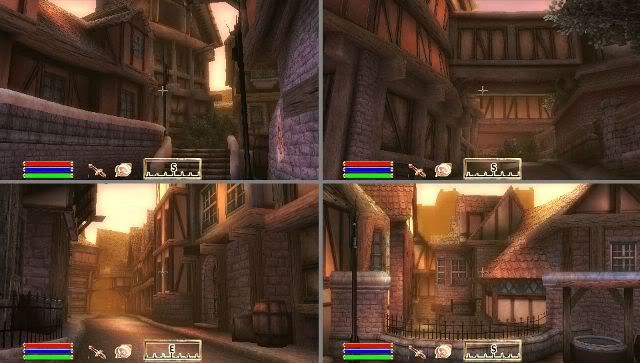
From what pics we do have, Oblivion on the PSP didn't look half bad
Although there was no official word of a cancellation, it was clear that when its reputed release date had come and gone (well after Oblivion itself had come out) with absolutely no mention of the game since then, it was safe to assume that Oblivion for the PSP been quietly shelved.
Gates of Ruin – Oblivion (2006)
“There’s always some new part of the world you’ve never seen, even if you’ve been playing the game for years. Vistas that make you stop and star in wonder for a few minutes. But at any time you’re always finding and seeing new things in how an NPC acts, or how a quest works, or something you’ve never seen that makes you smile and shake your head in amazement. There’s so much to see and do, it never gets old.”
– Pete Hines, Hardgamers interview, 2006
 The fourth major chapter of the series is perhaps the most well known – Oblivion. Bethesda Softworks' hopes on expanding beyond the PC market and into the highly lucrative console space had paid off with Morrowind's port over to the Xbox, and that dress rehearsal would pave the way for Oblivion's debut.
The fourth major chapter of the series is perhaps the most well known – Oblivion. Bethesda Softworks' hopes on expanding beyond the PC market and into the highly lucrative console space had paid off with Morrowind's port over to the Xbox, and that dress rehearsal would pave the way for Oblivion's debut.
Oblivion's development started shortly after Morrowind hit retail shelves back in 2002 and continued on since then with a number of technological teases in the following years. This time, it would be centered on the Imperial Province itself: Cyrodil, the heart of Tamriel. Like its predecessors, Oblivion was completely stand-alone – knowing what happened before was unnecessary, though references to past events held up the continuity of the Elder Scrolls' history.
With the assassination of the Emperor, Uriel Septim VII, the gates of Oblivion have been thrown open across the land with daedra free to wreak the customary havoc and devastation on the land. Only a true heir to Uriel Septim VII can hope to stop the invasion, and by this time, you already know who the Chosen One is going to be. Even though you're not the heir, the emperor had foreseen that you would be the one to find them and save the land – when you're not too busy pickpocketing people or exploring the countryside, that is.
Players could still set off and ignore the plight of the land if they wanted, plundering and honing their skills oblivious to the fiery portals of armageddon belching daedra into the countryside. They were free to develop whatever skills they wanted, pick the pockets of everyone they met, and slaughter anything in their path amidst a visual feast.
First, let me say that I enjoyed the long hours spent adventuring in Cyrodil, though as a veteran of the series, it was difficult not to take stock of a few little things that were missing. Despite offering the same free form adventurism that Arena, Daggerfall, and Morrowind had given adventurers over the years, Oblivion felt a little light on some of the details that I had taken for granted in the previous games.

These start popping up all over Cyrodil, like hellfire filled pimples of DOOM. The hellish
worlds beyond were a nice touch, though they could get repetitive after so many of these. But
they were a great source of random havoc and treasure hunting opportunities.
The Elder Scrolls series' character development system had gone through several changes with each major iteration, though it wasn't hard to see that there was an effort to streamline the process to make it more appealing to those that just wanted to hop in and start adventuring. Even though there were stock classes to start off with, customization had also been simplified to make it as immediate as the action by shedding more of the series' statistical weight. Whether or not that was a good thing depended a lot on who you spoke to.
Custom class options were trimmed with several more skills eliminated. The combat system was more forgiving – misses weren't as much a problem anymore despite your skill level. Fighters could join the Mage's Guild without having to worry about being too magically inclined and claim the title of Archmage. Dialogue choices were turned into a bizarre mini-game, a far cry from the deeply descriptive and keyword-friendly system used in Morrowind. It may not have felt like you were talking to a character straight out of a text adventure, yet it was hard to deny that some of the finer details felt lost in the translation.
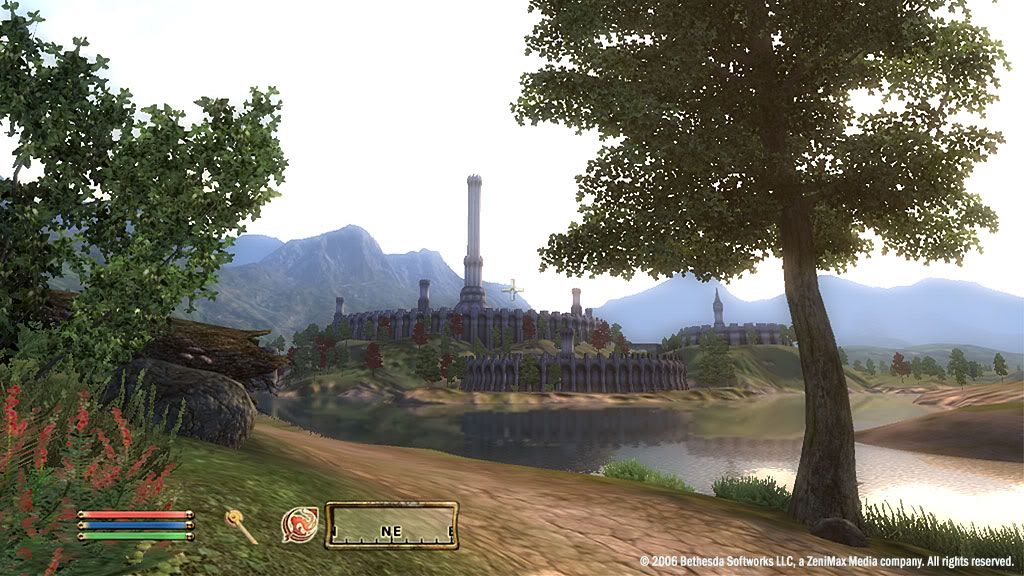
The Imperial City beckons from afar. And yes, you can get to the top of that tower,
though it would have been more exciting if they had left levitation in. Technical odds
and ends kept that useful spell out of the vanilla game, though mods would later "fix" that.
But the scaled leveling that Oblivion used had resulted in more than a few oddities such as bandits armored head to toe with the wealth of manors – or simple wildlife slaughtering high level characters. Players that had leveled their character through non-combat skills, like Mercantile and Security, could find themselves in for a brutal hazing when Khajjit bandits came calling with glass armor and swords.
The scaling had also restricted what the player might find, loot-wise; something of a change from Morrowind where you could stumble on exceptional equipment regardless of your experience. It was an issue that not everyone was happy about and ended up being one of the first things attacked with mods thanks to the included toolset.
The long touted Radiant AI gave life to its many NPCs who followed schedules and behaviors that were meant to make Cyrodil feel more alive. At the same time, Oblivion wasn't the only CRPG to have a its own societal mechanics as Piranha Bytes' Gothic series had also exhibited. And not all of the kinks had been worked out. Oblivion's AI could be both amazing for what it could do, especially in random situations that would simply occur as a result of another AI doing something else, and unintentionally amusing when it stood staring at you while a battle was taking place right next to it.
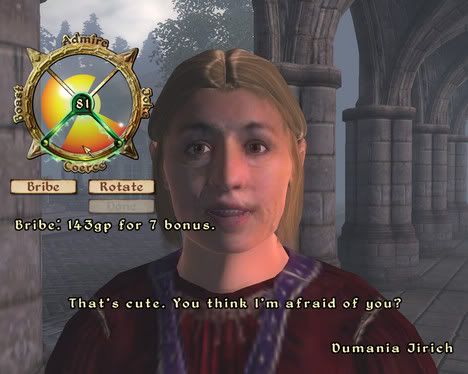
The persuasion mini-game was a hit and miss feature. Some would regard it as a
welcome change that gave speech impeded characters a fighting chance. Others saw
it as a regrettable act of "dumbing down."
At the same time, Oblivion's focus on its action oriented, be-everything, do-anything attitude glossed over many of these shortcomings especially if a player had never played any of the previous iterations. Even with its compromises, it still held onto the thrill of hitting the wilderness and swimming beneath the waves to discover just what might be waiting out there. There's also no doubt that Oblivion made it easier to be a godlike master of everything, not that many found too much fault with that approach when they were running across the land like armored juggernauts or sneaking invisibly through darkened caves.
Dungeons were plentiful, combat was crammed with action, and the world felt like a giant playground just waiting for me to do my worst. Being immersed in simply exploring Cyrodil's frontiers, skulking through the dark tunnels of a ruin, or pursuing an assassin's mark were the moments where Oblivion delivered the kind of experience that I would return to time and again in the hopes of finding a lead to that final quest.
Ancient Secrets – Knights of the Nine (2006)
 In November, a small expansion for Oblivion was released giving players a chance to resurrect a knightly order and fight a forgotten evil. Guess who gets to do the dirty work?
In November, a small expansion for Oblivion was released giving players a chance to resurrect a knightly order and fight a forgotten evil. Guess who gets to do the dirty work?
This kicked off a quest to recover the relics of an ancient, knightly order use them to destroy an ancient Ayleid sorceror king. Ayleids are a kind of elven race in the Elder Scrolls and they had once ruled an empire where the heart of the modern Imperial City now beats. They're the reason there are so many ruins scattered about.
In addition to the usual dungeons, there was also a knightly headquarters that could be rebuilt and made into another home for the player with recruits in addition to new arms and armor. Though it added a decent quest with a few snazzy rewards for my character's wardrobe, it was an experience that would last only an hour or two especially with my high level character decked out with what they had already hoarded.
Dance With the Devil in the Pale Moonlight – Shivering Isles (2007)
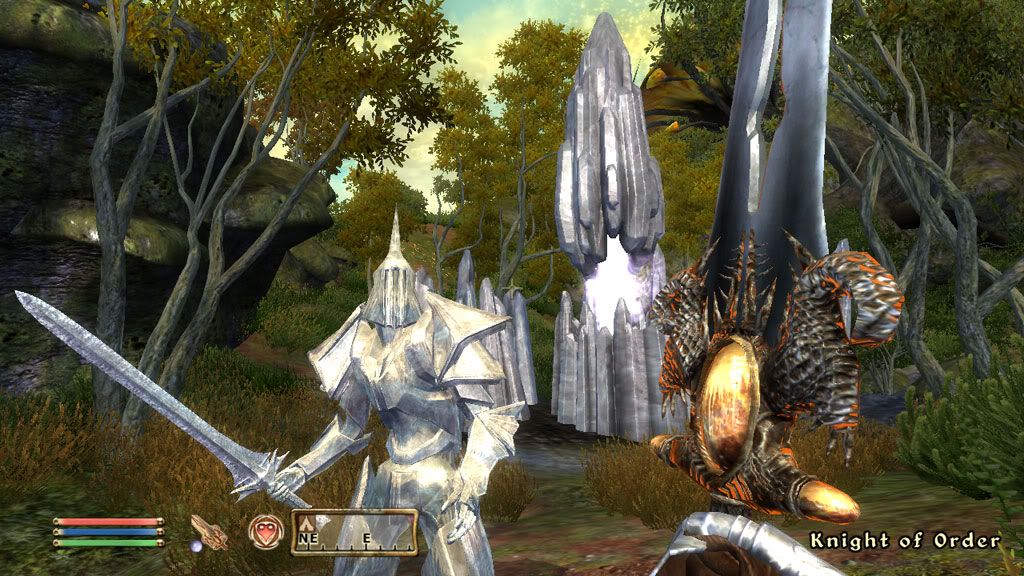 As if to make up for the thrifty size that Knights of the Nine was, Shivering Isles might as well have been its own RPG with thirty hours or more spent in exploring everything that was there. It added a new land to the game, the home of the daedric Prince of Madness, Sheogorath, who eventually calls upon the player to save his realm from destruction. Why would you want to do that? Because he's nuts, and he's promising really good stuff if you help him out.
As if to make up for the thrifty size that Knights of the Nine was, Shivering Isles might as well have been its own RPG with thirty hours or more spent in exploring everything that was there. It added a new land to the game, the home of the daedric Prince of Madness, Sheogorath, who eventually calls upon the player to save his realm from destruction. Why would you want to do that? Because he's nuts, and he's promising really good stuff if you help him out.
Towns, villages, and Sheogorath himself arrived with plenty of problems to sort through, most of these in a bid to stop the impending invasion by the dreaded Greymarch. Anyone that remembered their time in Morrowind's bleak fungus will be reminded of the same here, only with a lot more color and more oddness to battle through. As an NPC, Sheogorath's insanity made for some refreshing dialogue which was a nice change from the relative normalcy of Oblivion's world.
Like Knights of the Nine, you didn't have to complete the main game to experience everything that Shivering Isles had to offer though having a decently leveled character made the going easier. But if the player survived, they would return to Tamriel with a number of powerful new toys including a boon from Sheogorath himself making this a side trip worth taking.
Building a World, One Mod at a Time
Oblivion was a huge success on consoles as well as a first in some respects. For example, its horse armor is remembered more for the outrageous price it initially debuted at, though it represented the baby steps that the industry would take into the nascent microtransaction market that would come to define everything from DLC to avatar clothing.
Before the expansions, Bethesda sold smaller items such as new strongholds and dungeons though not all of them were particularly worth the price. This was especially true when players began tinkering with the free toolset allowing anyone to build their own dreamhomes or pack regular knives with enough power to slay anything that had even looked at you funny.

Ah, horse armor. How we can't forget you.
Thanks to that, the mod community quickly took the lessons learned from Morrowind into countless add-ons breathing even more life into Oblivion's world taking Bethesda's philosophy of openness to heart. Many of the most popular mods were either enhancements or self-made “fixes” to what PC players felt were 'consolized' features – textures were reworked, the interface retooled, and even the lighting was adjusted to breathe more life into the world. If Oblivion was going to be on a PC, it was going to feel as if it belonged there.

DarnNified UI is one of several mods that actually makes the interface worth looking at on the PC
New adventures, houses, and even monsters were pushed into the game thanks to Oblivion's moddability. As time went on, new tools were even programmed by fans to build on top of the toolset to do everything from managing mods to importing new 3D models.
Soon, places such as TES Nexus were bursting at the seams with everything from new swords and clothes to better looking models – depending on how much realism you wanted. If you wanted to fight a dragon, and if your rig could handle it, there was a mod for that, too. On the more extreme end of the scale were the total conversions, such as Nehrim, a German mod that uses Oblivion's engine and nothing else to build a unique and free RPG complete with its own NPCs, towns, and dungeons.
Even today and hundreds of hours later, even with every nook and cranny recorded on the 'net, Oblivion continues to lure players back into its world for one more thrilling expedition into the unknown – even if it is only for a little while.
Peeking Over the Horizon
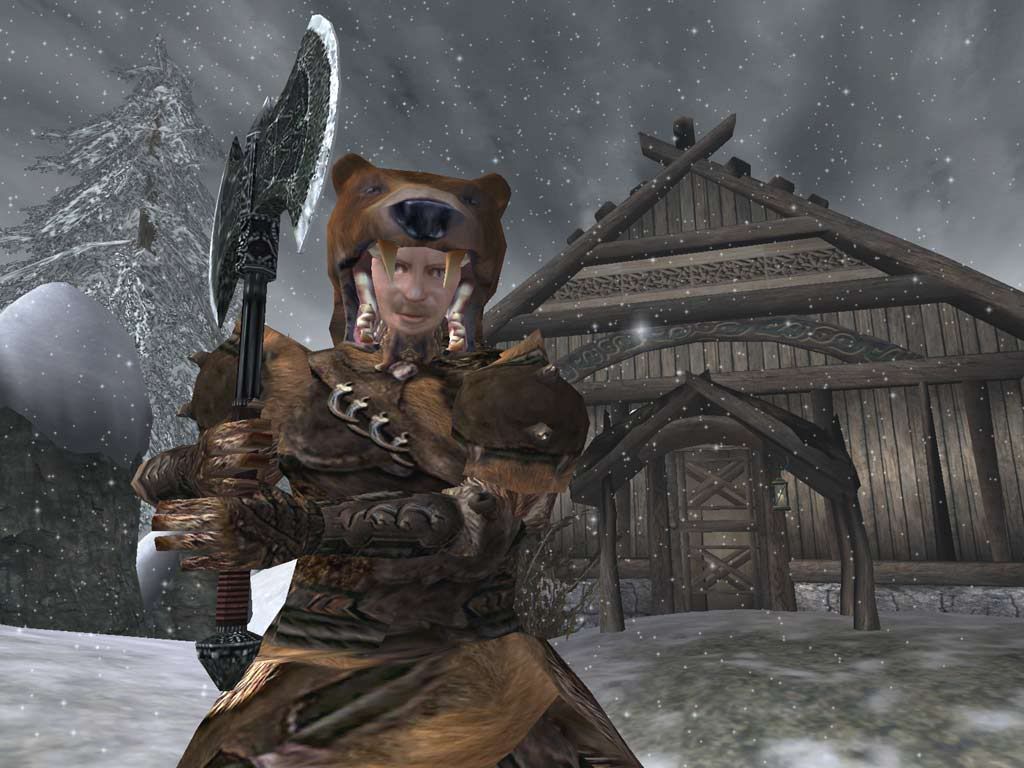 Skyrim will shortly join its brethren, but that still leaves four more provinces to cover: Elsweyr, Valenwood, Black Marsh, and Summerset Isle. And then there are the expansions that could follow each one, not to mention the tradition of modding that the series has enjoyed since Morrowind.
Skyrim will shortly join its brethren, but that still leaves four more provinces to cover: Elsweyr, Valenwood, Black Marsh, and Summerset Isle. And then there are the expansions that could follow each one, not to mention the tradition of modding that the series has enjoyed since Morrowind.
Even with the rise of MMOs in the years since Arena, the Elder Scrolls, along with several of its peers, have proven that single-player RPGs can still enthrall their audience when they can deliver both the gameplay, and the space, with which to write their own legends. Bethesda has a lot of material to tell new stories with in new ways, though it remains to be seen just how daring they are willing to be with it.
It's also easy to point to Bethesda's flirtation with titles such as Redguard, Battlespire, or their Travels series as misguided attempts to branch away from another free roaming uber adventure. Yet that also ignores the potential that such efforts also bring to the table: imagine a new adventure along the lines of Redguard, only with the gameplay of an Uncharted 3 or Mass Effect 2. Or an Assassin's Creed-style game casting the player as a member of the Morag Tong.
Tamriel's come a long way since Arena. Flush with a growing body of lore and the freedom that players have come to expect along the highways and inside the deep wilderness of its provinces, the final word on the Elder Scrolls will likely not be written by either the players or the designers for years yet to come.
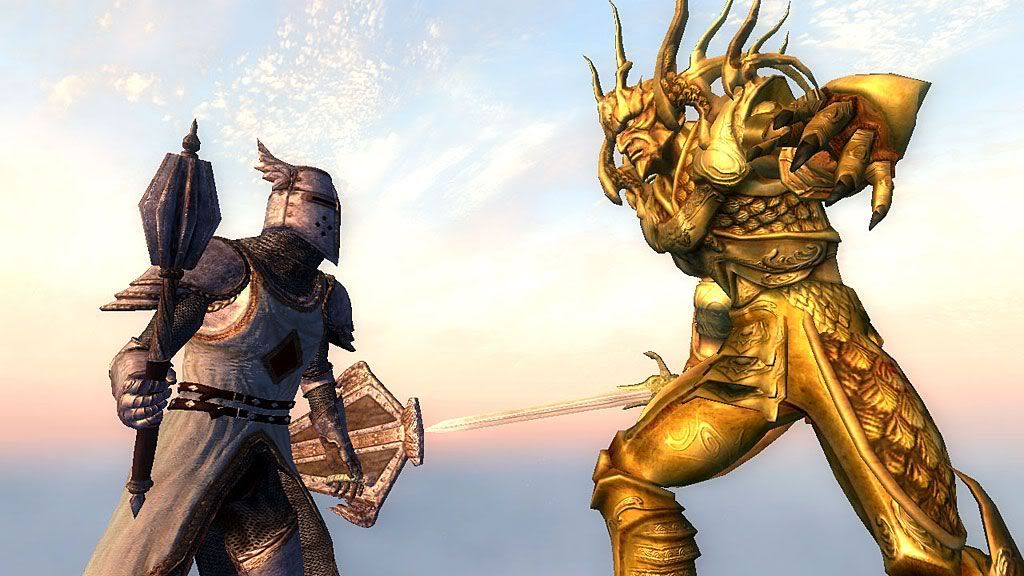
For Extra Reading
Helping me with this article were a number of sources in addition to my own experiences with many of the games. A lot of thanks go out to the Unofficial Elder Scrolls Pages, especially for the information covering the Elder Scrolls Travels mobile games.
General:
The Unofficial Elder Scrolls Pages
Morrowind Italia – Ted Peterson interview (April 9, 2001)
CGW Staff. "Company Report The House that Gretzky Built". Computer Gaming World. March 1993, p.102
Arena:
Wilson, Johnny L. “Fresh Blood in the Role Playing Arena – Politics, Peril, and Power in Bethesda's The Elder Scrolls, Volume 1: Arena.” Computer Gaming World. December 1993, p. 28
The Unofficial Elder Scrolls Pages – Arena
Daggerfall:
The Unofficial Elder Scrolls Pages – Daggerfall
Battlespire:
The Unofficial Elder Scrolls Pages – Battlespire
RPGWatch – Battlespire, an Elder Scrolls Retrospective by Lee Stanza (August 4, 2009)
Redguard:
The Unofficial Elder Scrolls Pages – Redguard
Morrowind:
Elder Scrolls III: Morrowind Interview with Todd Howard and Ken Rolston (June 8, 2000)
Interview with Morrowind's Developers by Game.EXE, July 2001 (reprinted at The Imperial Library)
The Unofficial Elder Scrolls Pages – Morrowind
The Elder Scrolls III: Tribunal Interview by Richard Aihoshi (October 31, 2002)
The Elder Scrolls III: Bloodmoon Interview by Richard Aihoshi (March 24, 2003)
Stormhold:
The Unofficial Elder Scrolls Pages – Stormhold
Shadowkey:
The Unofficial Elder Scrolls Pages – Shadowkey
The Artwork of Mark Jones – The Dragon's Eyrie for Shadowkey
Gamespy's Justin Leeper reviews Shadowkey (Jan 3, 2005)
Gamespot's Avery Score reviews Shadowkey (December 1, 2004)
1Up's Albert Art reviews Shadowkey (December 18, 2004)
Dawnstar:
The Unofficial Elder Scrolls Pages – Dawnstar
Oblivion (PSP):
The Elder Scrolls Travels: Oblivion Ventures to PSP (October 10, 2006)
Oblivion confirmed for PS3, PSP (September 27, 2006)
McWhertor, Michael “Oblivion PSP Finally Officially Canceled?." Kotaku. November 8, 2007
Oblivion:
The Unofficial Elder Scrolls Pages – Oblivion
Hardgamers interview with Pete Hines
Oblivion – DarNified UI mod
